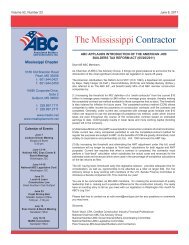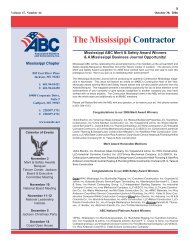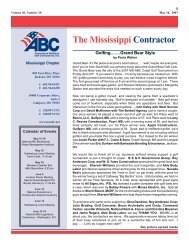§1904.6…Under the <strong>OSHA</strong> recordkeeping system, theemployer is always the responsible party when itcomes to making the determination of the recordabilityof a given case. However, if <strong>OSHA</strong> did not establishconsistent new case determination criteria, asubstantial amount of variability would be introducedinto the system, which would undermine theAgency’s goals of improving the accuracy and consistencyof the Nation’s occupational injury and illnessdata….…”[A]dopt a definition for new case that requiresthe occurrence of a new work-related event to triggera new case. In the absence of this, the case would beconsidered recurring.” …<strong>OSHA</strong> agrees… that if nofurther event or exposure occurs in the workplace toaggravate a previous injury or illness, a new caseneed not be recorded. However, if events or exposuresat work cause the same symptoms or signs torecur, the final rule requires employers to evaluatethe injury or illness to see if it is a new case and isthus recordable.The <strong>OSHA</strong> statistical system is designed to measurethe incidence, rather than prevalence, of occupationalinjury and illness. Incidence measures capturethe number of new occupational injuries and illnessesoccurring in a given year, while prevalence measurescapture the number of such cases existing in agiven year (prevalence measures thus capture caseswithout regard to the year in which they onset).Prevalence measures would therefore capture allinjuries and illnesses that occurred in a given year aswell as those unresolved injuries and illnesses thatpersist from previous years. The difference is illustratedby the following cases: (1) A worker experiencesa cut that requires sutures and heals completelybefore the year ends; this injury would be capturedboth by an incidence or prevalence measure for thatparticular year. (2) Another worker retired last yearbut continues to receive medical treatment for awork-related respiratory illness that was first recognizedtwo years ago. This case would be captured inthe year of onset and each year thereafter until itresolves if a prevalence measure is used, but wouldbe counted only once (in the year of onset) if an incidencemeasure is used.Because the <strong>OSHA</strong> system is intended to measurethe incidence of occupational injury and illness, eachindividual injury or illness should be recorded onlyonce in the system. However, an employee can experiencethe same type of injury or illness more thanonce. For example, if a worker cuts a finger on amachine in March, and is then unfortunate enough tocut the same finger again in October, this worker hasclearly experienced two separate occupationalinjuries, each of which must be evaluated for itsrecordability. In other cases, this evaluation is not assimple. For example, a worker who performs forcefulmanual handling injures his or her back in 1998,resulting in days away from work, and the case isentered into the records. In 1999 this worker hasanother episode of severe work-related back pain andmust once again take time off for treatment and recuperation.The question is whether or not the newsymptoms, back pain, are continuing symptoms ofthe old injury, or whether they represent a new injurythat should be evaluated for its recordability as anew case. The answer in this case lies in an analysisof whether or not the injured or ill worker has recoveredfully between episodes, and whether or not theback pain is the result of a second event or exposurein the workplace, e.g., continued manual handling. Ifthe worker has not fully recovered and no new eventor exposure has occurred in the workplace, the caseis considered a continuation of the previous injury orillness and is not recordable….…The term “new case” tends to suggest to somethat the case is totally original, when in fact newcases for <strong>OSHA</strong> recordkeeping purposes includethree categories of cases; (1) totally new cases wherethe employee has never suffered similar signs orsymptoms while in the employ of that employer, (2)cases where the employee has a preexisting conditionthat is significantly aggravated by activities atwork and the significant aggravation reaches thelevel requiring recordation, and (3) previously recordedconditions that have healed (all symptoms andsigns have resolved) and then have subsequentlybeen triggered by events or exposures at work.Under the former rule and the final rule, both newinjuries and recurrences must be evaluated for theirwork-relatedness and then for whether they meetone or more of the recording criteria; when these criteriaare met, the case must be recorded. If the caseis a continuation of a previously recorded case butdoes not meet the “new case” criteria, the employermay have to update the <strong>OSHA</strong> 300 Log entry if theoriginal case continues to progress, i.e., if the statusof the case worsens. For example, consider a casewhere an employee has injured his or her back liftinga heavy object, the injury resulted in medical treatment,and the case was recorded as a case withoutrestricted work or days away. If the injury does notheal and the employer subsequently decides toassign the worker to restricted work activity, theemployer is required by the final rule to change thecase classification and to track the number of days of42<strong>OSHA</strong> RECORDKEEPINGHANDBOOK
estricted work. If the case is a previous work-relatedinjury that did not meet the recording criteria andthus was not recorded, future developments in thecase may require it to be recorded. For example, anemployee may suffer an ankle sprain tripping on astep. The employee is sent to a health care professional,who does not recommend medical treatmentor restrictions, so the case is not recorded at thattime. If the injury does not heal, however, and a subsequentvisit to a physician results in medical treatment,the case must then be recorded….…In other words, a safety and health analysisshould give less weight to an injury or illness thathas a clear and relatively quick recovery withoutimpairment of any kind and an injury or illness that ischronic in nature or one that involves recurringepisodes that are retriggered by workplace events orexposures.Ignoring the fact that an occupational injury or illnessis a recurrence occasioned by an event or exposurein the workplace would result in an underestimateof the true extent of occupational injury and illnessand deprive employers, employees, and safetyand health professionals of essential information ofuse in illness prevention. The other extreme, requiringemployers to record on-going signs or symptomsrepeatedly, even in the absence of an event or exposurein the workplace, would result in overstating theextent of illness. In terms of the recordkeeping system,deciding how most appropriately to handle newcases requires a balanced approach that minimizesboth overrecording and underrecording. <strong>OSHA</strong> hasdealt with this problem in the final rule by carefullydefining the circumstances under which a chronicand previously recorded injury or illness must beconsidered closed and defining the circumstancesunder which a recurrence is to be considered a newcase and then evaluated to determine whether itmeets one or more of the recordability criteria….…The final rule uses one set of criteria for determiningwhether any injury or illness, including amusculoskeletal disorder, is to be treated as a newcase or as the continuation of an “old” injury or illness.First, if the employee has never had a recordedinjury or illness of the same type and affecting thesame part of the body, the case is automaticallyconsidered a new case and must be evaluated forrecordability. This provision will handle the vastmajority of injury and illness cases, which are newcases rather than recurrences or case continuations.Second, if the employee has previously had a recordedinjury or illness of the same type and affecting thesame body part, but the employee has completelyrecovered from the previous injury or illness, and anew workplace event or exposure causes the injuryor illness (or its signs or symptoms) to reappear, thecase is a recurrence that the employer must evaluatefor recordability.The implementation section of Section 1904.6describes these requirements and includes explanationsapplying to two special circumstances. In thefirst case, paragraph 1904.6(b)(1) the employee hasexperienced a chronic injury or illness of a type thatwill progress regardless of further workplace exposure.Cases to which this provision applies are serious,chronic illness conditions such as occupationalcancer, asbestosis, silicosis, chronic beryllium disease,etc. These occupational conditions generallycontinue to progress even though the worker isremoved from further exposure. These conditionsmay change over time and be associated with recurrencesof symptoms, or remissions, but the signs(e.g., positive chest roentgenogram, positive bloodtest) generally continue to be present throughout thecourse of the disease.The second kind of case, addressed in paragraph1904.6(b)(b)(2), requires employers to record chronicillness cases that recur as a result of exposures in theworkplace. These conditions might include episodesof occupational asthma, reactive airways dysfunctionsyndrome (RADS), or contact allergic dermatitis, forexample.Paragraph 1904.6(b)(3) recognizes the role ofphysicians and other licensed health care professionalsthat the employer may choose to rely on whentracking a “new case” or making a continuation of anold case determination. If a physician or otherlicensed health care professional determines that aninjury or illness has been resolved, the employermust consider the case to be resolved and record asa new case any episode that causes the signs andsymptoms to recur as a result of exposure in theworkplace. On the other hand, if the HCP consultedby the employer determines that the case is a chronicillness of the type addressed by paragraph1904.6(b)(1), the employer would not record the caseagain. In either case, the employer would evaluate itfor work-relatedness and then determine whether theoriginal entry requires updating or the case meetsthe recording criteria. Paragraph (b)(3) also recognizesthat the employer may ask for input from morethan one HCP, or the employer and employee mayeach do so, and in such cases, the rule requires theemployer to rely on the one judged by the employerto be most authoritative.§1904.6<strong>OSHA</strong> RECORDKEEPINGHANDBOOK43
- Page 1 and 2: www.osha.govOSHARecordkeepingHandbo
- Page 3 and 4: OSHARecordkeeping HandbookThe Regul
- Page 5 and 6: ContentsRecordkeeping HandbookRoadm
- Page 7 and 8: Section 1904.40Providing records to
- Page 9 and 10: Section 1904.0Purpose(66 FR 6122, J
- Page 11 and 12: Section 1904.1Partial exemption for
- Page 13 and 14: Section 1904.2Partial exemption for
- Page 15 and 16: employees, to OSHA within 8 hours (
- Page 17 and 18: Partial Exemptions for Employers Un
- Page 19 and 20: Section 1904.4Recording criteria(66
- Page 21 and 22: Section 1904.5Determination of work
- Page 23 and 24: (b)(7) How do I decide if a case is
- Page 25 and 26: well, including providing informati
- Page 27 and 28: This exception, which responds to i
- Page 29 and 30: or she is in the work environment a
- Page 31 and 32: have occurred but for the occupatio
- Page 33 and 34: considered work-related. If an empl
- Page 35 and 36: Question 5-12. Is work-related stre
- Page 37 and 38: • The doctor described the illnes
- Page 39 and 40: Scenario 7:• A site hired numerou
- Page 41 and 42: Letter of interpretation related to
- Page 43 and 44: These principles should be applied
- Page 45 and 46: The problem with the response is tw
- Page 47 and 48: Section 1904.6Determination of new
- Page 49: the Guidelines stated that “the a
- Page 53 and 54: • The doctor also prescribed the
- Page 55 and 56: • The employees were under the di
- Page 57 and 58: Section 1904.7General recording cri
- Page 59 and 60: (iii) Do I have to record restricte
- Page 61 and 62: of the length of time the employee
- Page 63 and 64: then result in days away from work
- Page 65 and 66: A partial day of work is recorded a
- Page 67 and 68: In all other respects, the final ru
- Page 69 and 70: ments. The Agency believes that the
- Page 71 and 72: e recorded because it will require
- Page 73 and 74: However, episodes of fainting from
- Page 75 and 76: care professional, he or she may al
- Page 77 and 78: “Other simple means” of removin
- Page 79 and 80: For purposes of OSHA recordkeeping
- Page 81 and 82: • When answering the doctor’s q
- Page 83 and 84: Response: In the recordkeeping regu
- Page 85 and 86: Letter of interpretation related to
- Page 87 and 88: Section 1904.8Recording criteria fo
- Page 89 and 90: caused by contaminated needles and
- Page 91 and 92: Section 1904.9Recording criteria fo
- Page 93 and 94: Section 1904.10Recording criteria f
- Page 95 and 96: hearing loss case that is not relat
- Page 97 and 98: average of 10 decibels or more at 2
- Page 99 and 100: argued that because the function of
- Page 101 and 102:
occurs, and where hearing loss can
- Page 103 and 104:
cases in their workplace via analys
- Page 105 and 106:
March 4, 2004Mr. Carl O. Sall, CIHD
- Page 107 and 108:
When the professional evaluating th
- Page 109 and 110:
(2) May I line-out or erase a recor
- Page 111 and 112:
Section 1904.12Recording criteria f
- Page 113 and 114:
These new statistics would add only
- Page 115 and 116:
Sections 1904.13 - 1904.28 Reserved
- Page 117 and 118:
two lines of the OSHA 300 Log to de
- Page 119 and 120:
which replace the OSHA 200 and 101
- Page 121 and 122:
different types of occupational ill
- Page 123 and 124:
OSHA 301 form. These data are usefu
- Page 125 and 126:
LETTERS OF INTERPRETATION: Section
- Page 127 and 128:
Question 2: Under 29 CFR Section 19
- Page 129 and 130:
and has adopted language in the fin
- Page 131 and 132:
Section 1904.31Covered employees(66
- Page 133 and 134:
label assigned to a worker is immat
- Page 135 and 136:
These workers should be evaluated j
- Page 137 and 138:
Response: A case is work-related if
- Page 139 and 140:
Response: Section 1904.31 states th
- Page 141 and 142:
Thank you for your interest in occu
- Page 143 and 144:
year covered by the summary. The su
- Page 145 and 146:
2. Number of employees and hours wo
- Page 147 and 148:
LETTERS OF INTERPRETATION: Section
- Page 149 and 150:
Section 1904.33Retention and updati
- Page 151 and 152:
June 23, 2003Mr. Edwin G. Foulke, J
- Page 153 and 154:
Section 1904.34Change in business o
- Page 155 and 156:
PREAMBLE DISCUSSION: Section 1904.3
- Page 157 and 158:
Incident Report (Forms 300 and 301,
- Page 159 and 160:
workers’ compensation claim. See
- Page 161 and 162:
LETTERS OF INTERPRETATION: Section
- Page 163 and 164:
Letter of interpretation related to
- Page 165 and 166:
Question 3: Using the facts in Ques
- Page 167 and 168:
Section 1904.37State recordkeeping
- Page 169 and 170:
tion, require employers to report f
- Page 171 and 172:
(5) If I receive a variance, may th
- Page 173 and 174:
Section 1904.39Reporting fatalities
- Page 175 and 176:
gation. Therefore, the final rule d
- Page 177 and 178:
Section 1904.40Providing records to
- Page 179 and 180:
ness. The government inspector may
- Page 181 and 182:
Response: The controlling employer
- Page 183 and 184:
FREQUENTLY ASKED QUESTIONS: Section
- Page 185 and 186:
OSHA and the BLS have worked togeth
- Page 187 and 188:
provide copies of the retained reco
- Page 189 and 190:
FREQUENTLY ASKED QUESTIONS: Section
- Page 191 and 192:
Section 1904.46Definitions(66 FR 61
- Page 193 and 194:
of business information. For exampl
- Page 195 and 196:
inconvenience associated with keepi
- Page 197 and 198:
skin disease, respiratory disorder,
- Page 199 and 200:
Question 2: Under 29 CFR Section 19
- Page 201:
www.osha.gov







